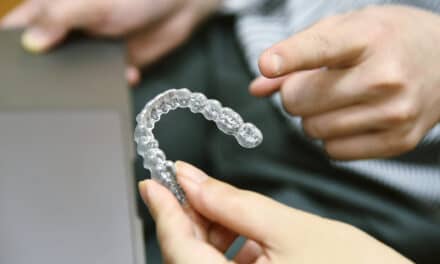
To combat this, a Transpalatal Arch (TPA) can be attached to resist this rotation. While mechanically sound, the TPA can lead to more patient discomfort and can slow intrusion because the entire unit must intrude together. TPAs also require added laboratory time and cost, and can have a considerable negative effect on speech and hygiene.
An alternative method for posterior intrusion with TADs, which controls rotation without the use of TPAs, is to place additional palatal TADs and use eyelet brackets on the first molar’s lingual surface. Two TADs can be placed in the palate between the second premolar and first Molar. (I recommend placing them with a contra-angle ratchet or hand driver.) As there is no wire to attach to on the lingual, you can bond an eyelet bracket (I use the Traction Hook from TP Orthodontics) to the lingual surface of the first molar and attach powerchain from the TAD, through the eyelet, and back to the TAD. With equivalent powerchain placed buccally and palatally, you can achieve controlled intrusion without using a TPA. This setup also allows for easy activation, with simple looping of powerchain at each visit and greater comfort for the patient.
This same setup can also be used for single-tooth intrusion, segmental intrusion, or with no wires at all if angulation and direction of force is accounted for.
—Joseph S. Petrey, MPH, DMD, MS
Somerset, Corbin, and Hazard, Ky










